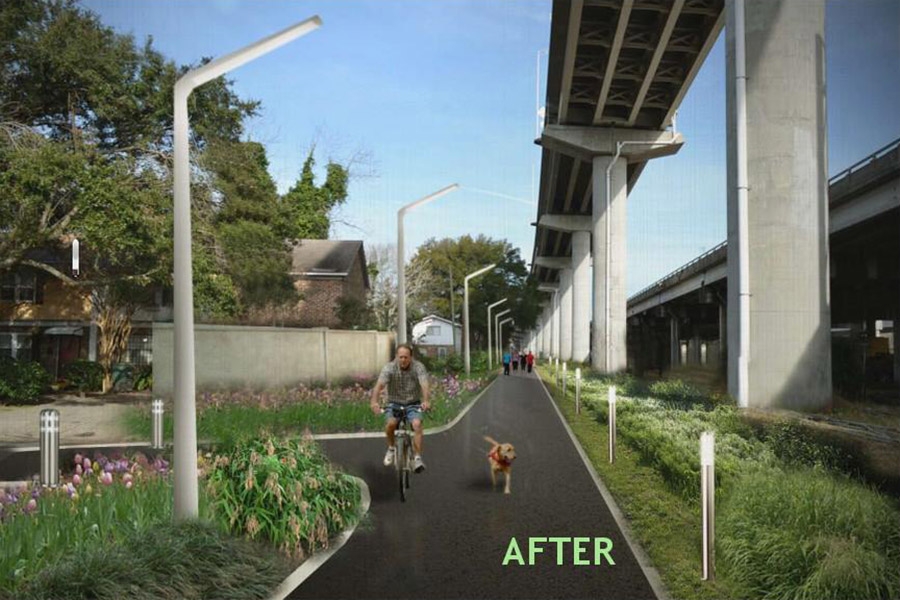
 |
 |
| A group of Georgia Tech students are helping take the first steps toward a project that would turn an abandoned rail line in Charleston into a 6.5-mile linear park. The image on the left shows one section of the rail today near Grove Street. The rendering on the right envisions how the area would look with the new Charleston Lowcountry Lowline. The student teams are doing early conceptual and storm water management work as part of their senior design projects. (Photos: Friends of the Lowcountry Lowline) | |
Some have called this project Charleston, South Carolina’s 21st century version of Central Park, the famed New York City green space.
Others have termed it a “keystone” to rejuvenating a blighted area of the city and to reuniting neighborhoods separated decades ago by the construction of Interstate 26. Supporters say it will drive the economic future of the entire city.
It’s called the Charleston Lowcountry Lowline, a project to turn an abandoned railroad line in the heart of the Charleston peninsula into a 6.5-mile linear park — and a group of Georgia Tech students are helping take the first steps to making the dream a reality.
 This map shows the proposed route for the first section of the Charleston Lowcountry Lowline. The project would turn an abandoned rail line into a linear park, inspired by Atlanta's Beltline and New York's High Line. The nonprofit Friends of the Lowcountry Lowline have secured the rights to buy this stretch of track from Norfolk Southern and now have two years to find the money. (Illustration: Jess Hunt-Ralston) This map shows the proposed route for the first section of the Charleston Lowcountry Lowline. The project would turn an abandoned rail line into a linear park, inspired by Atlanta's Beltline and New York's High Line. The nonprofit Friends of the Lowcountry Lowline have secured the rights to buy this stretch of track from Norfolk Southern and now have two years to find the money. (Illustration: Jess Hunt-Ralston)
|
“We think this is a great way to start connecting the lower part of the peninsula with the upper part of the peninsula,” project advocate Mike Messner told The Post and Courier newspaper. “It’s just the keystone.”
Messner, BSCE 1976, has been advocating for the park through his Speedwell Foundation, and he suggested students at his alma mater could help. This semester, a group of students from the School of Civil and Environmental Engineering and the School of City and Regional Planning are doing some of the early conceptual and engineering work as their senior design projects.
“This is a really good opportunity to bring both halves of Charleston together, and then also [connecting] north and south, too,” said Samantha Becker, a fifth-year civil engineering major who’s one of four CEE students involved.
“[This project] is kind of bits and pieces from all of our classes and putting it together to try to come up with something,” said environmental engineering major Shannon Evanchec, one of the others.
The Lowline’s proponents imagine it as Charleston’s version of the High Line in New York City, where a park was built on an abandoned elevated rail line, or Atlanta’s Beltline, which has transformed old rail tracks into a thriving park-cum-transportation-corridor encircling the city center.
The challenges are somewhat different in Charleston, however, where one of the key engineering goals, the students said, is to design the Lowline to manage the area’s frequent flooding while also serving as a recreational, cultural and transportation space.
“Charleston is different because it has more rainfall that New York or Atlanta does, and it is also lower elevation,” Evanchec said. “It makes the challenges for storm water management much more interesting.”
Evanchec, Becker, and environmental engineering majors Allison Findley and Alana Wilson are working on designs now that slightly elevate the trail and build a drain underneath to collect floodwater and direct it somewhere useful. They’ve traveled to Charleston to explore the area and talk to nearby residents. By the end of the semester, they’ll develop detailed plans and present them to the nonprofit Friends of the Lowcountry Lowline.
That group has secured the rights to buy the first mile and a half of the rail line from Norfolk Southern and has until late 2017 to come up with the money.
Friends of the Lowcountry Lowline will also hear from city and regional planning students who are evaluating how the park would integrate with nearby schools, parks, retail and historic locations, and tourist areas as well as the potential for economic redevelopment around the project.
“It’s interesting that our Senior Design project is preparing us for the real world,” Evanchec said.
“The actual project itself is very open-ended, which I like,” Becker said. “We can be very creative with it.”
